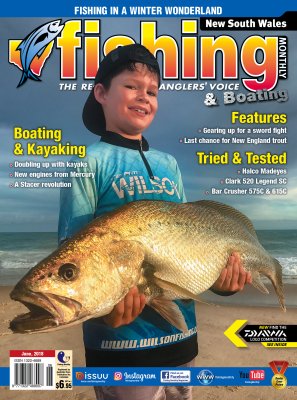Last chance for some New England trout by Wayne Kampe
 The 2017/18 trout season started with a good flush of water in the streams, and some sensational trout fishing was experienced throughout most New South Wales streams. It's a long-standing system; when the streams are well-supplied with water the fishing is at its best.
The 2017/18 trout season started with a good flush of water in the streams, and some sensational trout fishing was experienced throughout most New South Wales streams. It's a long-standing system; when the streams are well-supplied with water the fishing is at its best.
Up in the New England area, which is the most accessible trout fishery to my home in southern Queensland, the numbers of rainbows and browns in the rivers recently were as good as any I could remember. Successive trips saw even more top shelf flyfishing when the weather played the game.
Always weather-dominated, the New England trout waters hold plenty of fish but success usually depends upon just what the day throws up in the weather department. Too clear and hot conditions tend to make the fish very shy. Cold, bleak conditions will usually see them feeding very early or just on dark, but a calm, overcast day with little wind is like gold to the angler. At times like these, the fish will usually rise discreetly all day long.
CONDITIONS FAVOUR THE FISH
Fortunately, with winter now officially declared, the New England weather is going to favour the fish. Really cold nights are par for the course at this time of year, along with cool days that mandate the wearing of a few layers of clothing to keep warm.
While we anglers might be a bit soft and feel the uncomfortable change in season, the fish aren't bothered by it at all - they actually revel in it. Cool to cold weather will see the trout feeding hard to build up condition for the spawning runs to the smaller headwaters in all streams, which means that both browns and rainbows will take virtually all offerings that we anglers throw their way.
Seasonally hungry these trout may be, but stupid they are certainly not. Whether it's a fly, soft plastic or tiny spinner on your leader, if one of these wily trout detects any bumps or thumps from the bank, or you make any sudden movements, it's game over. As soon as the fish detects vibrations or other danger signs, it will head for the nearest bit of cover and remain hidden for quite a while.
To illustrate this, I once waited quietly on a spooked trout, as it was a particularly large one, to see how long it would take to come back on the job, and I was surprised to find it took over an hour for the next rise to occur. There's no happy ending to this story, as I missed the strike anyway!
So assuming that the weather conditions are good the fish will probably be about their business, so what could go wrong in the last gasp of the 2017/18 season? Rainfall records indicate that there has been a bit of a dry time in parts of the New England region, which means that streams could well be lower than expected for this time year.
Lowered water levels make things tough for both fish and anglers, as the fish will probably have less water to be comfortable in, so therefore they will be far easier to spook. The angler will also be somewhat easier to frustrate with the sight of bow waves from worried fish as they head for cover.
All is not lost though - you just need some forethought in your approach to skinny water, to turn the tables in your favour.